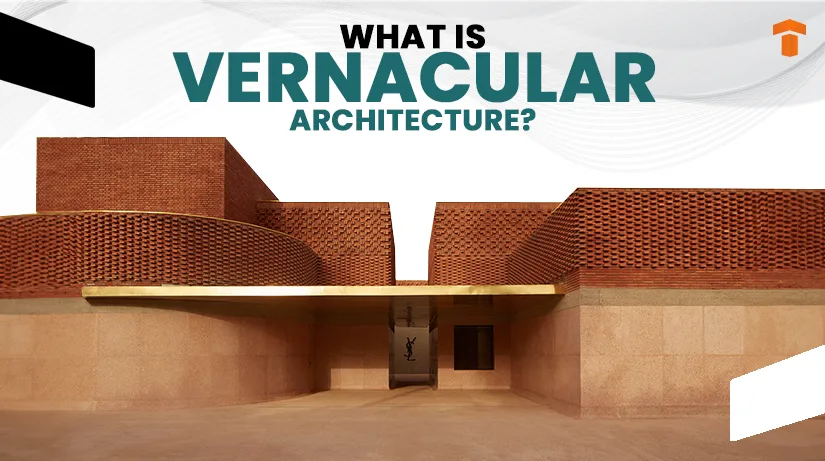What is Vernacular Architecture? A Complete Guide
Aug 21, 2024
Category: Others
Admin

Vernacular architecture also known as folk architecture is one of the most intriguing topics for AEC experts. This type of architecture can offer crucial insights to them on how to design structures that are functional, sustainable and also suit their locality well. Let’s learn more about this invaluable source of learning for modern architects.
Vernacular Architecture – Overview
Folk architecture is a style of building structure that utilizes locally available materials to build a place. It is the facet of architecture that underlines that it is closely associated with geography and cultural characteristics.
Vernacular architecture makes a structure stand out due to its distinctive material usage and design so much that one can easily identify that building as belonging to a particular region. Here is an example of this type of architecture: Local construction workers build these homes without the involvement of an architect.
Although such buildings have a broad array of designs, yet they are simple.
Types of Vernacular Architecture
As discussed above, traditional architecture differs according to the region and reflects the shades of a particular culture, climate, and locally available material. Below are some of the types of Indigenous architecture:
Mud and Adobe Structures

Source: Mother Earth News
Mud and adobe houses are prevalent in India and parts of the Middle East as well as North Africa. One can find mud houses in Rajasthan, India.
Thatched Roof Structures

Source: British Heritage Travel
Thatched roof buildings are common in areas such as England, Indonesia, and Africa. These structures have their roofs made from local vegetation, such as palm leaves and straw.
Stone Structures

Source: Architectural Digest India
Houses built with large stones are a common sight, especially in rural India. You can discover such houses in the Himalayas and also in Ireland as well as in the North American region that covers Alaska and Greenland. People use locally available dry stones to construct these homes through dry stone construction techniques.
Bamboo Structures

Source: MaterialDistrict
Southeast Asian people from countries such as the Philippines, Indonesia, and many more use bamboo to build homes. Bamboo is the primary material for building roofs, walls, and structural elements. Filipino nipa huts and Borneo’s longhouses are some of its examples.
Wooden Structures

Source: Old European culture
Wooden structures are popular in Scandinavian countries, Japan, and North America. These homes highlight the local woodwork traditions as they are made of wood. A few examples of wooden architecture are Japanese Minka houses, American colonial wooden houses, and Scandinavian log cabins.
Tropical vernacular structures, Pise de terre (rammed earth), courtyard houses, stilt houses, igloos and snow domes, nomadic tents and wattle and daub construction are the types of vernacular architecture.
Importance of Vernacular Architecture
Reflection of Culture
Traditional architecture stays at the forefront of offering the glimpses of culture, history and traditions of a specific area or community. The look of these structures matches the local customs and needs. These buildings show something special about their people or place. Hence, it is an ideal way to showcase a culture’s roots to the world.
Community Building
The whole community participates in building as well as maintaining the indigenous structures and it can instill a sense of pride and ownership among the members of the community. As a result, community building can ensue.
Preservation of History
Folk architecture is etched in the history of a place and it conveys the message of the culture and identity of a community. Protection and preservation of cultural architecture can lead to preserving the history as well as the identity of a community or place.
Sustainability
Vernacular architecture has a close relationship with the natural environment, as homes are made of local resources. This method of construction is much more sustainable as well as resource-efficient than the professionally designed structures of the modern era.
Local Techniques Suit Local Climate
People are well aware of the climate of their locality and use the construction materials that are available in their area in the traditional architectural method. These resources suit the local climate, landscape, and way of life. These buildings stay warm in cold places and cool in warmer places.
Functionality
Houses constructed through vernacular architecture methods are designed after reflecting on the functionalities, such as requirements, materials, and cultural values of the people.
Unique to Every Place
This type of architecture creates a distinctive style of building homes based on the available resources and requirements.
Evolving Design
Traditional designs can keep evolving as the local construction workers hone their skills and also learn through their experience, which can result in improving the design as time progresses.
Examples of Vernacular Architecture in India
Bhunga, Kutch, Gujarat

Bhunga houses are traditional, especially in the Kutch region of Gujarat. To build these houses, people use a single cylindrical thatch roof on top and a rafter and a wooden post to support it. This house has mud brick walls, which have a door and door windows for ventilation. The circular shape of this home offers protection from the extreme heat and also limits the stress of an earthquake.
Koti Banal, Uttarakhand

Koti Banal buildings are usually 2-3 stories high and are earthquake-resistant. Locals have been building these houses in Uttarakhand for more than 900 years. People live in the upper storey and also use it as an attic for storing grains, while they have in-house cattle on the lower storey.
First, locals lay a foundation and they use dry masonry to raise a structure above it. On the front, they add a gate on the ground floor and also add windows that face south. This house has balconies covering the entire structure on the upper two floors and wooden railing as well as wooden logs help it be cantilevered into the home.
The walls of this building are 50 to 60 centimeters thick. Construction workers use timber-reinforced stone masonry along with pulse paste as mortar to build them. A wooden structure supports the roof and slate tiles cover it.
Bamboo House of Assam

Assam is the state where flood occurrences are very common as they take over the state almost every year. Hence, the bamboo houses are made at a significant height and they have walls made from timber frames. Local people embed ikra panels (a weed that grows in lakes and rivers in Assam) in the timber frames and cover them using three layers of mud mortar plaster.
Bamboo houses have open spaces in the front as well as the backside. People prefer hip or gable roofs as they prevent waterlogging and they can build them using grass that can last for up to 10 years.
Conclusion
Vernacular architecture is a vast topic and comprises multiple facets that can be discussed at length and can prove beneficial for aspiring architects. Leverage the information from this blog and make the most of your potential as an architect.
FAQs
Q1. How is vernacular architecture useful for people?
Ans. Vernacular or traditional architecture promotes the utilization of locally available materials, such as bamboo, mud, grass and wood, etc., to construct a home. These homes can be built with the climate of a place in mind.
Q2. Which materials are used to build homes through folk architecture?
Ans. According to their area, people use bamboo, stone, thatch, timber, lime, cob, grass, wattle and daub as well as straw and hay to construct the homes.
Q3. How can vernacular architecture be helpful for young architects?
Ans. Young architects can read and analyze this type of architecture to understand of the local building techniques and materials. They can also learn the relationship between architecture and the climate of an area, the culture and architectural heritage as well as societal influences.








